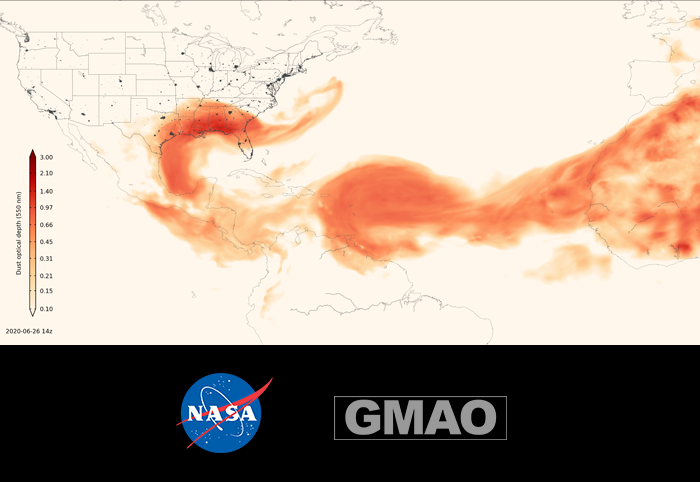Atmospheric Dust Rivers: Saharan Dust Makes the Journey to the Americas
Mineral dust lifted from desert surfaces is the largest source of terrestrial aerosol particles in Earth’s atmosphere. Dust can be transported over thousands of kilometers, and dust from the Sahara Desert is the most visible and persistent aerosol feature on Earth. During its journey across the tropical western Atlantic, Caribbean islands, and the Americas, Saharan dust interacts with Earth’s climate system by scattering and absorbing radiation from the Sun and Earth’s surface and changes the properties of cloud systems encountered. Dust near the surface is a hazard to human populations by adversely affecting air quality and impacting surface visibility, and dust deposited to the surface is an important source of minerals that fertilize oceanic and terrestrial ecosystems.
During June 2020 an enormous pulse of Saharan dust was forecast and observed to cross the Atlantic into the Caribbean and predicted to impact the US Gulf Coast states and be recirculated over the mid-Atlantic region as far north as Maryland and Pennsylvania. Ground-based observations in the Caribbean Islands of Barbados and Guadeloupe and in the US territory of Puerto Rico showed the highest overhead aerosol loadings in their approximately 20-year record, and surface measurements in Puerto Rico confirmed particle concentrations at nearly three times the 24-hour EPA standard limit for healthy quality conditions. This was a truly extraordinary event.
GEOS aerosol assimilation products show the progress of this event, from its origin over the Saharan Desert source regions and through its intercontinental transport and its extend over the US. Early analysis of this event suggests that a high pressure weather system near Africa confined dust lifted over the Sahara Desert to swirling around over its source region before a shift of the weather system finally allowed the built up dust plume to emerge and be carried west by the prevailing winds. Further analysis with the GEOS model is ongoing to improve its predictive and descriptive capabilities to forecast and evaluate such events in the future.
The animation above is available at two higher resolutions: 720p, 1080p.


